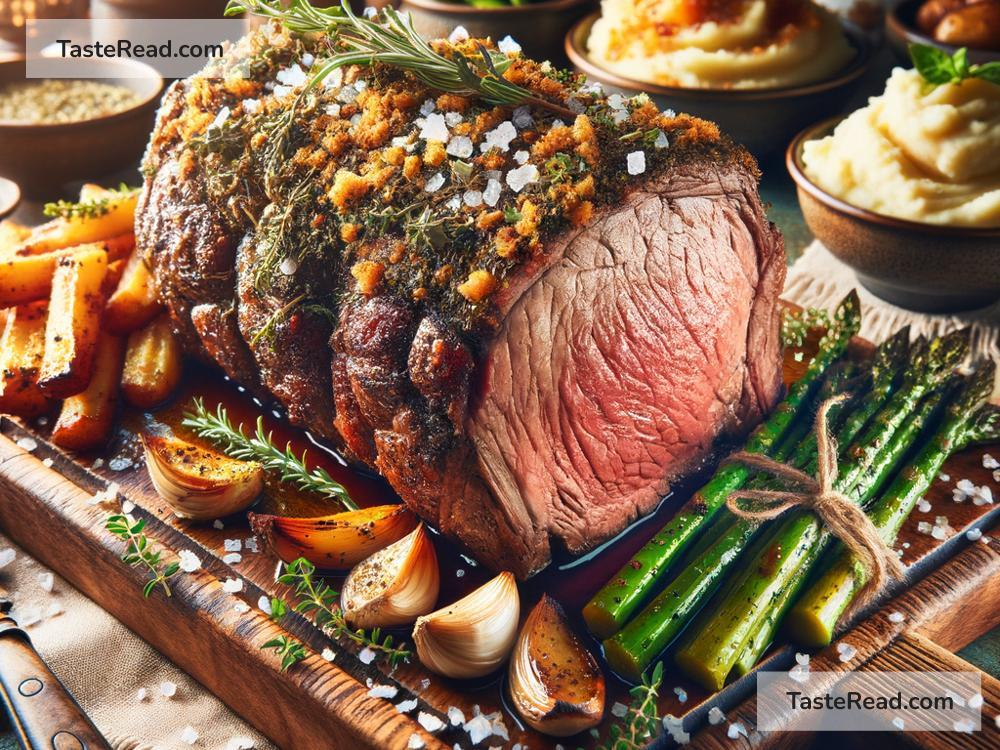How to Prepare a Delicious, Aromatic Herb-Crusted Prime Rib Roast
Prime rib roast is a holiday favorite, but you don’t need to save it for a special occasion! With the right mix of herbs and a simple cooking method, you can serve this mouthwatering dish any time and impress your family or guests. In this guide, we’ll show you how to make a flavorful, tender, and aromatic herb-crusted prime rib roast. Don’t worry, it’s easier than it seems—it’s all about using the right ingredients and cooking techniques.
Step One: Gather Your Ingredients
To make a prime rib roast that is packed with flavor, you’ll need fresh herbs, garlic, and a few staple ingredients. Here’s what you’ll need:
For the roast:
– 1 prime rib roast, about 4 to 6 pounds (bone-in is ideal!)
– 2 tablespoons olive oil
For the herb crust:
– 3 cloves garlic, minced
– 2 tablespoons fresh rosemary, finely chopped
– 2 tablespoons fresh thyme, finely chopped
– 2 tablespoons fresh parsley, finely chopped
– 1 tablespoon coarse salt
– 1 tablespoon cracked black pepper
– 1 teaspoon paprika (optional, for color)
You’ll also need a roasting pan, a wire rack, and a meat thermometer for this recipe.
Step Two: Preparing the Herb Crust
The herb crust is what gives the prime rib its incredible aroma and flavor. Start by chopping your fresh herbs finely and mixing them in a small bowl with minced garlic, salt, pepper, and paprika. Add the olive oil to create a paste—this will help the herbs stick to the meat and form a beautiful crust during cooking.
Step Three: Prepping the Meat
Remove the prime rib roast from the fridge and let it sit at room temperature for about 30 minutes. This step is important because cooking cold meat straight from the fridge can result in uneven cooking.
Place the roast on a clean surface. If your roast has a layer of fat on top, leave it on—it will enhance the flavor of the meat as it cooks. Rub the herb paste generously all over the surface of the meat, making sure you coat it evenly. Don’t forget the sides!
If your roast is bone-in, you can tie the meat with butcher’s twine to secure it to the bones. This isn’t crucial, but it helps ensure the roast cooks evenly and holds its shape.
Step Four: Roasting
Preheat your oven to 450°F (232°C). This initial high heat will help sear the outside of the roast and lock in the juices.
Place a wire rack inside a roasting pan to elevate the meat. Lay the prime rib roast on the rack, fatty side up. Roast it in the oven at 450°F for 15 minutes. This burst of heat will create a golden crust. After 15 minutes, lower the oven temperature to 325°F (163°C).
Cook the meat at this lower temperature until it reaches your desired doneness. Use a meat thermometer to check the internal temperature—this is crucial for perfectly cooked prime rib:
– Rare: 120-125°F
– Medium rare: 130-135°F
– Medium: 140-145°F
For a medium-rare roast, plan on cooking it about 15 minutes per pound, though the exact time can vary.
Step Five: Resting the Meat
When the roast reaches the right temperature, remove it from the oven and cover it loosely with aluminum foil. Let it rest for 20-30 minutes. Resting is super important because it allows the juices to redistribute throughout the meat, making it tender and juicy.
Step Six: Carving and Serving
Use a sharp carving knife to slice the roast. If you’re working with a bone-in prime rib, carve it between the bones to create perfect slices. Aim for slices about ½ inch thick.
Prime rib roast pairs beautifully with sides like creamy mashed potatoes, roasted vegetables, or even a simple green salad. You can also make a quick au jus (a light beef sauce) using the drippings from the roasting pan for extra flavor.
Tips for Success
- Use high-quality meat: A great prime rib roast starts with good-quality beef. Look for a roast with nice marbling (fat running through the meat), as this keeps it tender and flavorful.
- Don’t skip the thermometer: Guessing when your roast is done can lead to overcooking. A meat thermometer takes the guesswork out and ensures perfect doneness every time.
- Fresh is best: Fresh herbs bring out vibrant flavors, so avoid using dried herbs for this recipe unless absolutely necessary.
Conclusion
Making an herb-crusted prime rib roast might sound intimidating at first, but with these simple steps, it’s totally achievable—even if you’re new to cooking large cuts of meat. The blend of garlic, fresh herbs, and seasoning creates an irresistible crust, while the roasting method keeps the meat juicy and tender.
This recipe is perfect for holiday feasts, dinner parties, or even a cozy weekend dinner. Once your family or friends take their first bite, they’ll be begging you for seconds. So roll up your sleeves, gather your ingredients, and get ready to make a prime rib roast that will steal the show!
Happy cooking! 🎉


